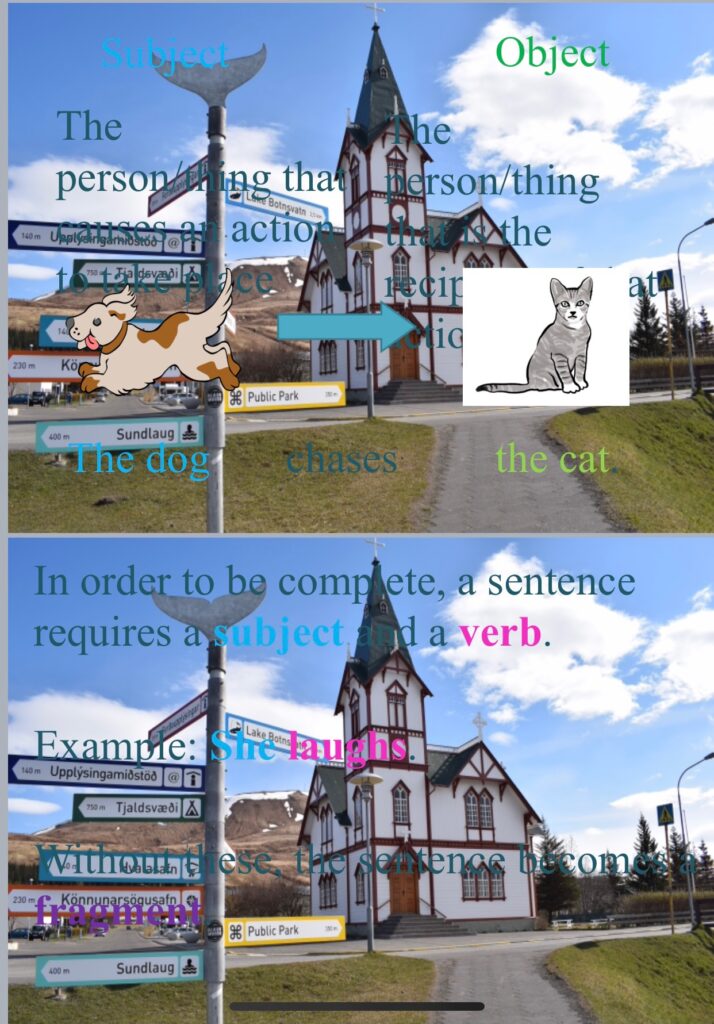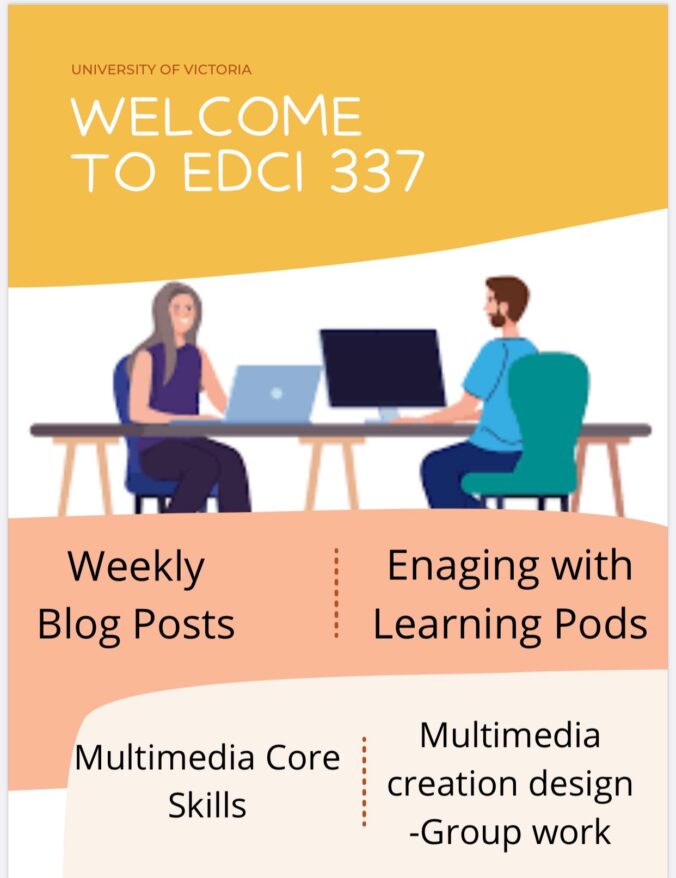Video’s can be a very beneficial multimedia tool if created properly. After COVID-19 shut down the school, school moved to an online system. Here, professors did a range of multimedia tools to delivery their course material. Many of my Professors used videos to explain the class lectures. I will use the SECTIONS model to evaluate my previous class’s video lectures. To begin, my professors target was the students enrolled in the class. However, many students were forced to move back home which could mean a different time zone. With these videos, students can watch the lectures on their own time. Next, the new platform of Brightspaces made watching these videos easy to use. There were often categorized to make it easy to find a certain video. I am uncertain about the Costs and teaching function details of these videos. But, the interaction was often clear. The learning material was directed to the learners. If a learner was unclear about the material, the student can reach to the expert (professor) for clarity. Moreover, the university provided useful platforms for recording videos and posting them. This helped avoid organizational issues. Next in the model is networking. Professors would often provide other readings and videos that relate to the course material. However, this information is not always in the videos. The final step to SECTION is security and privacy. I always felt safe when watching the videos, as it was on a safe platform. Overall, it seems like my professors followed the steps in creating successful videos.
Page 2 of 2
Sketchnotes is a great delivery method when working with learner with ADHD. Sketchnotes are visual creative hand drawings about a certain topic (Rohde, 2013). Along with hand drawings, there are often written words and audio to explain the material. This is beneficial because the viewer can read, visualize and hear what is being explained. Sketchnote videos are often fast-paced but engaging to watch. This can help the learners who struggle to pay attention. The video shows many different drawings to explain the concept in a short video. In my opinion, this method helps me understand the concept the most.
For example, this method is a great way to understand COVID-19. In this video, they use pictures and hand writing while providing an explanation.
Since this is one of my favourite ways to learn, I want to learn how to create these videos for my future students. However, I am not very artist or creative. After watching “Sketchnoting for College Students,” I still believe I would not be able to make a decent Sketchnote. I made one but, I would not feel comfortable sharing for a learner. My goal is to practice creating these Sketchnotes so I can use this in my career. I will practice by using different colours, sizes, and drawings. Hopefully after practice, I will be able to produce my own Sketchnote.
I could not agree more with using both words and pictures to explain new things. The human mind works in different ways and multimedia delivers to allow for all types of learners to understand (Mayer, 2005). The example of the bicycle pump reminded me when I recently had to set up a desk. The desk instructions had only pictures to explain how to set up the desk. The screws were labeled by numbers but that was it. The first step in the instructions already looked half set up. I was confused on how to get the desk to look like step one. After a while, I was able to figure it out by using the one image. I think my experience would have been better if there were written instructions as well as images. Separately, the written and image instructions would be able to get the final step. The written instructions would be hard for me to follow but with pictures to guide me, it would make the process easier. Some people may only use the picture, some may use only the written, and some may use both. The goal is to set up the desk. The instructions are there to help you get there. Thus, multi-delivery methods are useful in all learning areas.
Visual multimedia methods can be helpful and engaging to the viewer. By using pictures and colours, more people would be curious to see what the sign, or poster has to say. Moreover, posters, infographics, and brochures tend to be easy to read, understand, and follow along. They should be simple with only highlights of information. A crowed poster would loose the attention of the reader if there is too much text, small text, and bland colours.
I made a poster via Canvas to indicate EDCI 337 course outline. This could be used to advertise the course to other students. This could also be used for summarizing the course outline if students struggle to understand the website.
The poster has “University of Victoria” at the top so students know what school/location this class is being taken place at. The it have the course title in a larger font to stand out the viewers. Then there is a picture of students on their laptop to show this is an online class. At the bottom, there is four sections which make up of the marks for the course. Viewers can see this poster and get an understanding of what to expect in the course.
Posters and Infographics tend to be easy to read and follow along. Thus, It is important to incorporate these methods into my future teaching lessons. For example, if the classroom is learning about outer space, the teacher can design a poster with labels, colours, and pictures. Then the class would have an understanding of what they are about to learn. The students can relate new information back to the original poster. Overall, visual delivery methods can help more students understand the information.
This weeks topic informed me of different learning theories. I have not learned much about these different theories and how it can affect the learner. However, now that I have more knowledge, I am able to understand these theories better. For example, I have used behaviorism methods at the summer camp I work at. All the campers have special needs and learn and cooperate differently. Since communication was often an issue, it was hard to establish rules, goals, and expectations in the camp. Thus, I used the behaviourist theory. I would reward good behavior, completing tasks, and listing to the leaders. This worked well for some of the campers but not all. Other theories like cognitive and constructivist would not work as well with children with special needs. These theories are more learner centered methods.
Moreover, I agree with Phillips points about death by PowerPoint. I often struggle following slides as well as listening to my professors lecture. I find that there is often too much text on slides which causes confusion. Recently, I had to read over a PowerPoint from a class I missed.

The PowerPoint was chaotic and hard to follow. The Background of the PowerPoint has a picture with buildings, street signs and many different colours. This made it hard to read the text on the slide. Phillips guide to a good PowerPoint would make my learning experiences better. One idea per slide would allow learners to focus on that one idea as well as being able to listen to the lecture.
References
Phillips, David JP. (2014, April 14). How to avoid death by PowerPoint [Mp4]. TED Talks. https://www.youtube.com/watch?v=Iwpi1Lm6dFo
Brain Health. (2021). The University of Texas at Dallas. https://brainhealth.utdallas.edu/center-for-brainhealth-public-lecture-series-brings-nationally-recognized-e/
My name is Rianne Yuen. I am currently in my fourth year at UVic. My goal is to become an elementary school teacher by majoring in sociology and minoring in education.
The last three summers, I worked for a summer camp with special needs children, where I was inspired to become a teacher. During the camp we worked on basic life skills while enjoying the summer! Also, I was an assistant coach for a local ringette team where I was able to help notice and improve players skills. Now, I started working at a daycare as a support worker for a little boy with autism. This has allowed me to practice my early childhood teaching skills by slowly teaching him basic classroom policies. Overall, my experience has lead me to become a teacher in the future.
Moreover, I am currently living in Victoria BC, with four other roommates that are also attending UVic. I enjoy going for walks, hikes and watching the sunset.
If you have any cool places to walk or hike in near Victoria, comment below!
-Rianne
As a future teacher, I want to provide multiple different methods of teaching. In order for this, I need to learn different methods including multimedia and Interactive learning. In my education timeline, I have found multimedia a great way to learn and understand material. There is often videos with images, titles, labels, and direction to help one learn. For example, I did not understand a math question. I used YouTube to look for a video to help explain better. In the video, the creator used signaling principles and modality principles. The video had images and printed texts as well as highlighted important numbers of the question. This allowed me to easily follow along and comprehend the information. I would like to learn how to create videos like “The Signaling Principle” to help my future students learn. In my own experience, I struggle with paying attention and multitasking. When the teacher provides written slides, talks and draws diagrams, I can easily get lost. This causes me to not understand the material and have to look elsewhere for clarification. Thus, multimedia is a great way to delivery knowledge. Videos tend to be organized and easy to follow along. Videos can also be entertaining to the viewers, allowing them to stay focused. Learning more about this method can improve my teaching methods. Overall, I am excited to learn more about multimedia and interactive learning.
References
Mayer, R. E. (Ed.). (2014). The Cambridge Handbook of Multimedia Learning (2nd ed.). Cambridge University Press. https://doi.org/10.1017/CBO9781139547369







